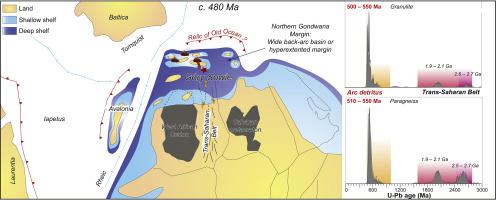当前位置:
X-MOL 学术
›
Gondwana Res.
›
论文详情
Our official English website, www.x-mol.net, welcomes your
feedback! (Note: you will need to create a separate account there.)
Evolution of a Cambro-Ordovician active margin in northern Gondwana: Geochemical and zircon geochronological evidence from the Góry Sowie metasedimentary rocks, Poland
Gondwana Research ( IF 7.2 ) Pub Date : 2021-02-01 , DOI: 10.1016/j.gr.2020.10.011 A.S. Tabaud , P. Štípská , S. Mazur , K. Schulmann , J. Míková , J. Wong , M. Sun
Gondwana Research ( IF 7.2 ) Pub Date : 2021-02-01 , DOI: 10.1016/j.gr.2020.10.011 A.S. Tabaud , P. Štípská , S. Mazur , K. Schulmann , J. Míková , J. Wong , M. Sun

|
Abstract The Gory Sowie Massif (GSM) in Poland represents a Devonian high-pressure–ultrahigh-pressure (HP–UHP) terrane dominated by paragneiss, with subordinate orthogneiss, metabasite and felsic granulite. Whole-rock geochemistry of four migmatitic paragneiss and five granulite samples from the northern part of the GSM was combined with U–Pb–Lu–Hf isotopic data on zircon in order to constrain the sedimentary provenance, tectonic setting and paleogeographic location of the sedimentary paleo-basins now forming the GSM. Granulite and paragneiss protoliths are geochemically analogous to flysch-like graywacke and point either to a continental arc or an active continental margin setting dominated by Cambrian felsic arc detritus. Detrital zircon age spectra record a dominant Ediacaran to Cambrian population (493–600 Ma) with rare clusters of Palaeoproterozoic to Neoarchean age (1900–2100 Ma and 2400–2700 Ma). These reflect a peri-Gondwana provenance in the vicinity of the Trans-Saharan belt and place firm constraints on the age of sedimentary protolith of paragneisses at the middle to late Cambrian. Except one sample, the felsic granulites show only late Cambrian depositional ages. The zircon overgrowth rims give two age clusters, one at c. 397–402 Ma that possibly records a HP metamorphic event, and the other at c. 379–393 Ma that probably records the timing of a high-temperature event including migmatization during exhumation. This tectono-thermal event was coeval with emplacement of Devonian ophiolitic rocks that surround the GSM. The GSM rock association, degree and timing of metamorphism and coeval ophiolite emplacement resemble closely the Galicia-Tras-os-Montes middle and upper allochthonous units in NW Iberia and in the Munchberg Massif in Germany. We suggest that all these massifs were in close spatial proximity before the Devonian and may form part of a single, now tectonically dismembered, terrane or archipelago, which was located along the northern periphery of the Gondwana margin during the Cambro–Ordovician.
中文翻译:

冈瓦纳北部寒武纪活动边缘的演化:来自波兰 Góry Sowie 变质沉积岩的地球化学和锆石年代学证据
摘要 波兰的 Gory Sowie 地块 (GSM) 代表了泥盆纪高压-超高压 (HP-UHP) 地体,以副片麻岩为主,其次为正方麻岩、变碱性麻粒岩和长英质麻粒岩。来自 GSM 北部的 4 个混合质副片麻岩和 5 个麻粒岩样品的全岩地球化学与锆石的 U-Pb-Lu-Hf 同位素数据相结合,以限制沉积古的沉积物源、构造环境和古地理位置。 -现在形成GSM的盆地。花岗岩和副片麻岩原岩在地球化学上类似于复理石样灰岩,并且指向大陆弧或以寒武纪长英质弧碎屑为主的活动大陆边缘环境。碎屑锆石年龄谱记录了占主导地位的埃迪卡拉纪至寒武纪种群(493-600 Ma)以及稀有的古元古代至新太古代(1900-2100 Ma 和 2400-2700 Ma)群。这些反映了横贯撒哈拉带附近的冈瓦纳大陆周边物源,并对中晚寒武纪副片麻岩的沉积原岩年龄施加了严格的限制。除一个样品外,长英质麻粒岩仅显示晚寒武世沉积时代。锆石过度生长边缘给出了两个年龄簇,一个在 c。397-402 Ma 可能记录了 HP 变质事件,另一个在 c。379-393 Ma 可能记录了高温事件的时间,包括剥脱过程中的迁移。这一构造热事件与围绕 GSM 的泥盆纪蛇绿岩的侵位同时发生。GSM摇滚协会,变质作用的程度和时间以及同时期蛇绿岩的侵位与伊比利亚西北部和德国蒙克伯格地块的加利西亚-特拉斯-奥斯-蒙特斯中上和上外地单元非常相似。我们认为,所有这些地块在泥盆纪之前都在空间上非常接近,并且可能形成一个单一的、现在被构造肢解的地体或群岛的一部分,在寒武纪-奥陶纪期间,该地块或群岛位于冈瓦纳边缘的北部边缘。
更新日期:2021-02-01
中文翻译:

冈瓦纳北部寒武纪活动边缘的演化:来自波兰 Góry Sowie 变质沉积岩的地球化学和锆石年代学证据
摘要 波兰的 Gory Sowie 地块 (GSM) 代表了泥盆纪高压-超高压 (HP-UHP) 地体,以副片麻岩为主,其次为正方麻岩、变碱性麻粒岩和长英质麻粒岩。来自 GSM 北部的 4 个混合质副片麻岩和 5 个麻粒岩样品的全岩地球化学与锆石的 U-Pb-Lu-Hf 同位素数据相结合,以限制沉积古的沉积物源、构造环境和古地理位置。 -现在形成GSM的盆地。花岗岩和副片麻岩原岩在地球化学上类似于复理石样灰岩,并且指向大陆弧或以寒武纪长英质弧碎屑为主的活动大陆边缘环境。碎屑锆石年龄谱记录了占主导地位的埃迪卡拉纪至寒武纪种群(493-600 Ma)以及稀有的古元古代至新太古代(1900-2100 Ma 和 2400-2700 Ma)群。这些反映了横贯撒哈拉带附近的冈瓦纳大陆周边物源,并对中晚寒武纪副片麻岩的沉积原岩年龄施加了严格的限制。除一个样品外,长英质麻粒岩仅显示晚寒武世沉积时代。锆石过度生长边缘给出了两个年龄簇,一个在 c。397-402 Ma 可能记录了 HP 变质事件,另一个在 c。379-393 Ma 可能记录了高温事件的时间,包括剥脱过程中的迁移。这一构造热事件与围绕 GSM 的泥盆纪蛇绿岩的侵位同时发生。GSM摇滚协会,变质作用的程度和时间以及同时期蛇绿岩的侵位与伊比利亚西北部和德国蒙克伯格地块的加利西亚-特拉斯-奥斯-蒙特斯中上和上外地单元非常相似。我们认为,所有这些地块在泥盆纪之前都在空间上非常接近,并且可能形成一个单一的、现在被构造肢解的地体或群岛的一部分,在寒武纪-奥陶纪期间,该地块或群岛位于冈瓦纳边缘的北部边缘。











































 京公网安备 11010802027423号
京公网安备 11010802027423号